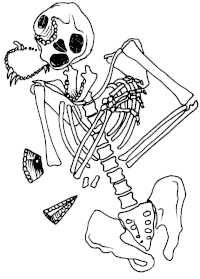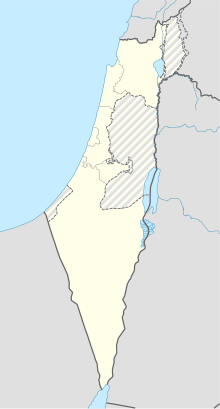| Revision as of 16:38, 19 January 2022 edit41.243.40.211 (talk) →HistoryTag: Reverted← Previous edit | Revision as of 15:55, 28 January 2022 edit undoDziecko Fortuny (talk | contribs)6 editsm An unnecessary fragment has been deleted.Tags: Manual revert Visual editNext edit → | ||
| Line 38: | Line 38: | ||
| ] and ] excavated in the cave in the early 1930s, but by far the most significant discovery made at Kebara Cave was ] in 1982, the most complete postcranial ] ] found to date. Nicknamed "Moshe" and dating to ''circa'' 60,000 ], the skeleton preserved a large part of one individual's torso (], ]s and ]). The ] and most of the lower limbs were missing. The ] was also preserved, and was the first Neanderthal hyoid bone found.<ref name="mithen">](2006). The Singing Neanderthals: The origins of music, language, mind, and body. Cambridge, Massachusetts: Harvard University Press.</ref> | ] and ] excavated in the cave in the early 1930s, but by far the most significant discovery made at Kebara Cave was ] in 1982, the most complete postcranial ] ] found to date. Nicknamed "Moshe" and dating to ''circa'' 60,000 ], the skeleton preserved a large part of one individual's torso (], ]s and ]). The ] and most of the lower limbs were missing. The ] was also preserved, and was the first Neanderthal hyoid bone found.<ref name="mithen">](2006). The Singing Neanderthals: The origins of music, language, mind, and body. Cambridge, Massachusetts: Harvard University Press.</ref> | ||
| The ] culture is named after the site |
The ] culture is named after the site. | ||
| == See also == | == See also == | ||
Revision as of 15:55, 28 January 2022
| Kebara Cave | |
|---|---|
 Kebara 2 in situ Kebara 2 in situ | |
  | |
| Location | Zikhron Ya'akov, Israel |
| Coordinates | 32°33′29.8″N 34°56′14.3″E / 32.558278°N 34.937306°E / 32.558278; 34.937306 |
| Elevation | 60 to 65 m (197 to 213 ft) above sea level |
| Discovery | Early 1930s |
| Geology | Limestone |
Kebara Cave (Hebrew: מערת כבארה Me'arat Kebbara, Arabic: مغارة الكبارة Mugharat al-Kabara) is an Israeli limestone cave locality in Wadi Kebara, situated at 60 to 65 m (197 to 213 ft) above sea level on the western escarpment of the Carmel Range, in the Ramat HaNadiv preserve of Zichron Yaakov.
History
The cave was inhabited between 60,000 and 48,000 BP and is famous for its excavated finds of hominid remains, made under the direction of Professor Ofer Bar-Yosef.
Dorothy Garrod and Francis Turville-Petre excavated in the cave in the early 1930s, but by far the most significant discovery made at Kebara Cave was Kebara 2 in 1982, the most complete postcranial Neanderthal skeleton found to date. Nicknamed "Moshe" and dating to circa 60,000 BP, the skeleton preserved a large part of one individual's torso (vertebral column, ribs and pelvis). The cranium and most of the lower limbs were missing. The hyoid bone was also preserved, and was the first Neanderthal hyoid bone found.
The Kebaran culture is named after the site.
See also
- Ramat HaNadiv
- Archaeology in Israel
- List of fossil sites (with link directory)
- List of hominid fossils
- List of transitional fossils
- List of notable fossils
References
- "map" (PDF). Archived from the original (PDF) on 2013-10-10. Retrieved 2013-10-11.
- Mithen, S.(2006). The Singing Neanderthals: The origins of music, language, mind, and body. Cambridge, Massachusetts: Harvard University Press.
Further reading
- Schick, T. & Stekelis, M. "Mousterian Assemblages in Kebara Cave, Mount Carmel", Eretz-Israel 13 (1977), pp. 97–150.
- Bar-Yosef, O. & B. Vandermeersch, et alii, "The Excavations in Kebara Cave, Mount Carmel", Current Anthropology 33.5 (1992), pp. 497–546.
- Goldberg, P. & Bar-Yosef, O., "Site formation processes in Kebara and Hayonim Caves and their significance in Levantine Prehistoric caves", in T. Akazawa, K. Aoki and O. Bar-Yosef (eds), Neandertals and Modern Humans in Western Asia, New York & London: Plenum Press, 1998, pp.?
- Albert, Rosa M., Steve Weiner, Ofer Bar-Yosef, and Liliane Meignen, "Phytoliths of the Middle Palaeolithic Deposits of Kebara Cave, Mt. Carmel, Israel: Study of the Plant Materials Used for Fuel and Other Purposes", Journal of Archaeological Science 27 (2000), pp. 931–947.
- Lev, Efraim, Kislev, Mordechai E. & Bar-Yosef, Ofer, "Mousterian Vegetal Food in Kebara Cave, Mt Carmel", Journal of Archaeological Science 32 (2005), pp. 475–484.
External links
- Ramat Hanadiv - the Rothschild Memorial public gardens at Ramat HaNadiv preserve the Kebara Cave within their boundaries for visitors
- Kebara Cave at About.com
| Epipalaeolithic Southwest Asia | |||||||
|---|---|---|---|---|---|---|---|
| Cultures |
| ||||||
| Sites |
| ||||||
| Caves in Israel | |
|---|---|
| Israel | |
| Neanderthal | |||||||||
|---|---|---|---|---|---|---|---|---|---|
| Ancestors | |||||||||
| Biology | |||||||||
| Tool traditions | |||||||||
| Regional variants | |||||||||
| Notable specimens |
| ||||||||
| Fossils with claimed Neanderthal traits |
| ||||||||
| Contemporary species | |||||||||
| Research | |||||||||
| Popular culture | |||||||||
| Documentaries | |||||||||